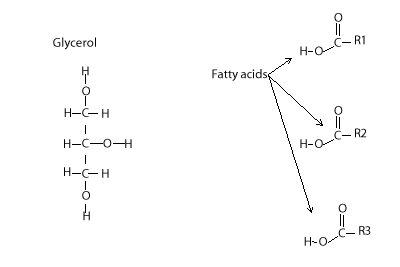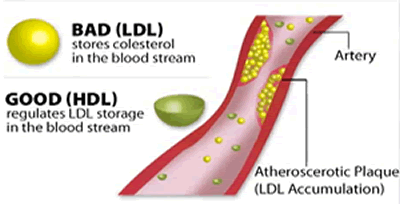|
Food chemistry Fats and ester links |
||
|
Excess chemical energy consumed by the body is usually stored as fat. Fat is stored in special tissues called adipose tissue. Fat contains a great deal of energy per gram, in fact it contains twice the energy of carbohydrates per gram, and is also a good insulator. |
||
 |
Most fats are formed by a condensation reaction involving hydroxyl (OH) and carboxyl (COOH) functional groups. When these two functional groups react they form an ester link. Fatty acids absorbed from the food and not required for energy are stored in adipose tissue as triglycerides. Triglycerides are formed from fatty acids and glycerol (as shown on the left) Look at the animation on the left. For every ester link formed a water molecule is given off as a product. In the small intestine, enzymes act in an alkaline environment to catalyse the hydrolysis of triglycerides into fatty acids and glycerol. These fatty acids and glycerol are absorbed through the intestinal wall where they undergo a condensation reaction back into triglycerides. |
|
Triglycerides are either ingested by humans as part of the diet or synthesized in the liver from excess carbohydrates. They are then transported in blood as part of lipoprotein particles. Dietary triglycerides are transported as part of lipoprotein particles called chylomicrons as are other lipids, such as cholesterol. Triglycerides synthesized in the liver are transported as part of lipoprotein particles called very low density lipoproteins or VLDLs. Triglycerides are then removed from lipoprotein particles as they reach the target cells. Cells use the triglyceride immediately, or it is stored in adipose tissue. View the video on the right. Why is it necessary to transport lipids as part of a protein complex? Is the formation of an ester bond between a carboxyl (COOH) and hydroxyl (OH) functional groups an example of an acid base reaction? Explain. Solution Fats and oils are commonly known as lipids. What two functional groups are responsible for the formation of lipids? What type of reaction forms a lipid? What are the products of a hydrolysis reaction of a lipid? |
||
 |
Cholesterol is used by the body in small amounts to make bile, vitamin D, hormones and is also an essential ingredient of cell membranes. Cholesterol is transported around the body bound to lipoproteins that make it soluble in water. Two types of lipoprotein transports cholesterol, low-density-lipoproteins (LDL) and high-density lipoprotein (HDL). When the amount of cholesterol in the blood increases, by factors such as diet, the body responds by making more LDL to carry the excess cholesterol in the blood. LDL has been labeled as the bad cholesterol as it builds up on arterial walls forming a plaque. that can obstruct the flow of blood to vital areas such as the heart. |
|
Plaque causes the blood vessels to harden leading to the condition known as atherosclerosis. This can cause a stroke or heart attack. The video on the right shows the formation of a plaque.
|
||